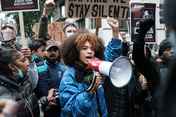Building a brand
No matter how worthwhile your project is, you’ll probably only have a matter of seconds in which to make a favourable initial impression with your most important audience – youth. Youth are sophisticated consumers of design, language and underlying intent. Developing a coherent and appealing brand is your best shot at engaging their attention long enough to tell them more about why they should set aside 20 minutes to answer questions about their lives. A brand is the shorthand version of the promise you make about who you are and what you stand for, wrapped in a stylistic package that resonates with your audiences. The biggest companies spend millions of dollars building, promoting and protecting their brands. You have to be more efficient. The main tools you have are who you are, your key messages, and visual elements like colour, typeface and images.
Survey name
In formal project documents and communications, including the survey questionnaire, UNICEF Canada requires you to incorporate the formal name of the survey (the “UNICEF Canada Community Child and Youth Well-being Survey”) as much as possible. But when you are communicating directly to potential youth participants, something shorter and catchier is in order. You can use a youth-friendly name (such as the “Anytown Youth Impact Survey”) but must pair it with the formal name in formal project communications (“Youth Impact: the 2021 Anytown Community Child and Youth Well-being Survey”). Almost certainly, young people are going to be better at coming up with this name than adults. The UNICEF Canada Licensing Agreement provides the core requirements for naming convention.
NOTE: One way to choose a name is to hold a “green-light” brainstorming session, where youth are invited to quickly suggest names on sticky notes with the promise that there are no bad suggestions. The goal is to generate energy around the challenge, spark out-of-the-box thinking and maximize the volume of options. Nobody gets to comment on what anyone else says until all the ideas are captured and displayed in a way that everyone can see. You can then engage the group in a productive conversation and employ fun tactics like “dot-mocracy” voting that narrows down the options to just a few that you can test with a larger group through social media.
The Children and Youth Planning Table of Waterloo Region brought together more than 70 youth at a “youTHINK” event to review the survey questionnaire and help with marketing and promotion. Youth, both at the event and those connected through social media, were invited to suggest names for the survey and then vote on the winner. Based on this process, they called their survey the Youth Impact Survey – a name that telegraphed the idea that completing the survey was a way for youth to affect decisions relating to them.
Tagline or Call-to-Action
Here you have the luxury of a few more words to make the case for why youth should get involved. You can use the same creative brainstorming process as you did for the survey name, remembering that how the name and tagline work together is important. For example, to communicate that this is a unique opportunity, options might include, “Make your voice heard,” “Your opinion counts,” or “Making our community a great place to grow up.” Many young people who have advised previous community surveys say that their main motivation to take the survey – and a key message to convey – is to help other young people by influencing decisions that will make their community a better place for young people.
Visual elements
You may want to create visual elements, such as a graphic “stamp” or icon for social media posts (e.g., images, filters and frames) and video elements. This is almost always best executed by graphic design professionals. They will make sure they understand who they are targeting and what feelings these assets are meant to evoke, while applying a level of polish that will lend weight to the communications. Ideally, these professionals can observe a Youth Lab or help facilitate a creative session with youth. In particular, they will be careful to ensure that any imagery they recommend is inclusive of your community’s diversity and any desired brand elements. UNICEF Canada provides graphic elements as part of its licensing agreement that represent the survey dimensions; these can be incorporated but not altered.
Using the survey logo
The UNICEF Canada Licensing Agreement specifies the required use and placement of the UNICEF Canada name and logo for the Community Child and Youth Well-being Survey. The logo should not be used in any other application unless written approval is secured from UNICEF Canada. The agreement also specifies where the community partner(s) name and logos may not be placed (e.g., on the survey questionnaire). The community partner(s) is encouraged to develop agreed usage guidelines for where all partners will place their logos in relation to the project (e.g., the survey host web page, press releases, data report, promotional posters, PowerPoint slides). Some communities have developed their own graphic “stamp” for their survey name, such as the Youth Impact Survey in Waterloo Region. This is not the same as an organizational logo.
See Appendix for sample brand elements.





































